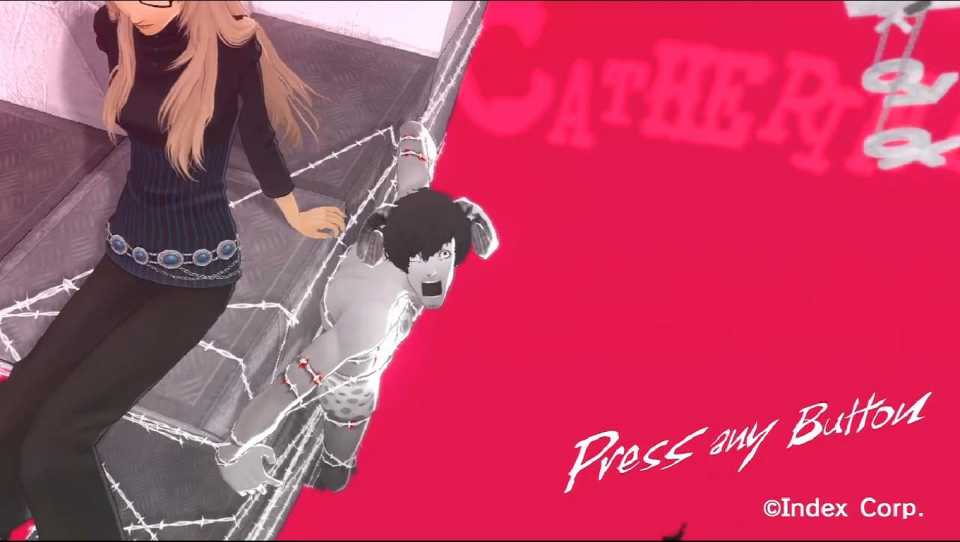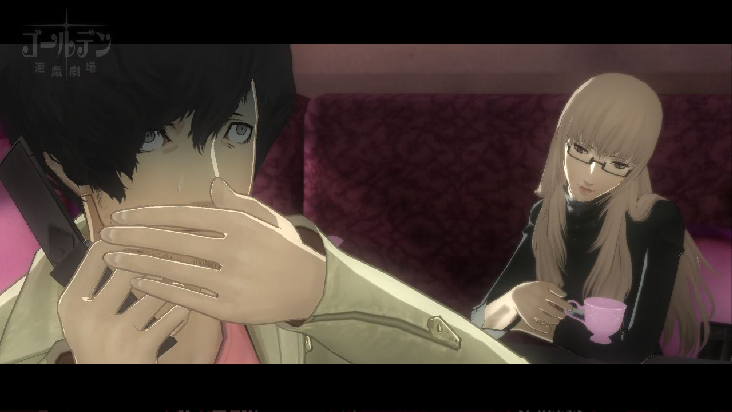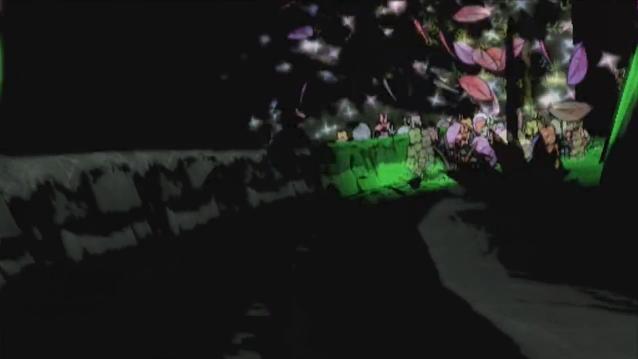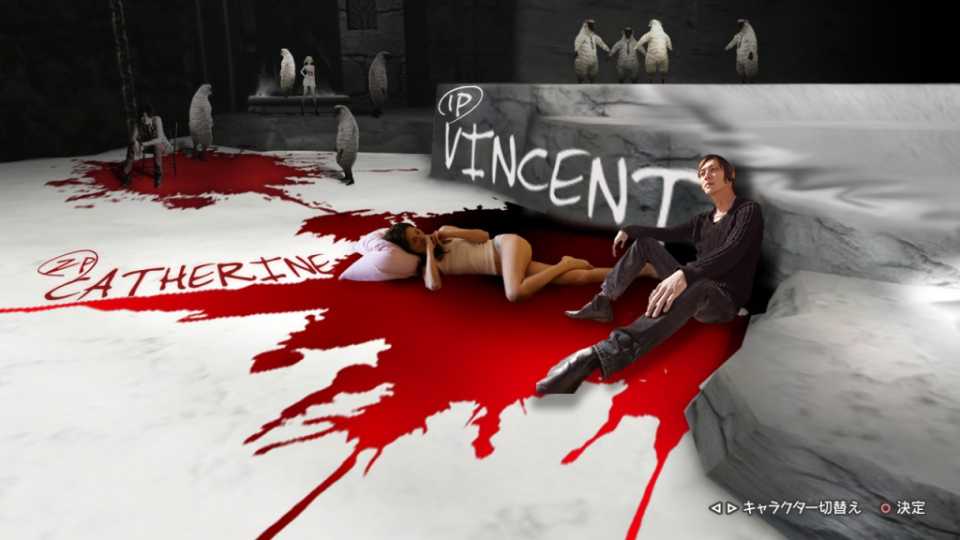On Title Screens and the Lessons Still Not Learned From Catherine
By Pepsiman 35 Comments

As Atlus games are regularly wont to do with me, Catherine is a game that I still regularly think about, a somewhat remarkable feat on its part considering more time has passed for me since I played it compared to the majority of the game's western players. Although much of what I had to say about the game was encapsulated in my review and the subsequent retrospective blog post, the contents of both of which I continue to stand by, there are still a few things I've left unsaid in the nearly two years since I last wrote about it in any major capacity. I've never actually discussed the mini-crisis I had in deciding the game's score, for instance, its last plot arc, like with many other reviewers, having left me feeling jarred and struggling to figure out whether it was sufficient enough to bump the game down to three stars or not. (It was never going to garner a five out of five either way, though, despite how much I may personally like it.) Likewise, I've never mentioned how one scene late in the game actually deeply disturbed me in a way I doubt few other games will ever replicate and how that scene's ability to tap into one of the darkest parts of my memory is one reason I find the game to be largely successful to me personally on an emotional level. The one largely unmentioned thing that still lingers in my mind most and what I want to focus on in this ever-so-rare new blog post, though, is Catherine's title screen.
From what I've personally noticed, whenever people discuss Catherine's visuals at any length, the dialog is usually centered on a few very specific topics. Chief among them, naturally, is the game's aesthetic style and the bemusing notion that the same engine that powered much of Fallout 3 and New Vegas could somehow be used to produce something that's so striking to see. Yet rarely have I seen the blog posts and forum messages delve much deeper beyond that and provide a proper analysis of the game's imagery. This could entirely be due to my own incompetence at finding the places where that's actually being discussed, but by and large the conversation on the artistic side of Catherine seems to focus only on its superficial style, rather than its substance. That's a huge shame since, like many of Atlus' other games before it, a deeper understanding of the symbolism behind the game's scenery is hugely beneficial to understanding it on a deeper thematic level. While I'd be happy to talk at length about a number of visual elements in Catherine, I feel its title screen in particular is important to note since it's very quietly subversive of a lot of video game standards when it comes to that element specifically. So much so, in fact, that if Catherine's influence isn't felt in future games as a result of its plotline and its attempts to meaningfully make a game targeted at an adult audience, then I hope at least some developers out there are taking notes about what its title screen has to say, for they show that they way things have to be done is hardly as fixed as it so often seems.
However, let's quickly go over what your typical title screen achieves in terms of both visuals and functions to provide a better context of the general precedence that's come before and after Catherine's. Although I'm fully confident that anybody on this site reading this blog knows what a title screen is in at least basic terms, I still have things to say about what specifically constitutes normal ones and why those things are the standard bearers, so be patient with me if it seems like I'm initially discussing things that don't need to be reviewed. To begin, I've provided several examples of title screens in the image set above, one from each major console generation, plus one pre-NES era one in the form of Wizardry's. Title screens tend to exist for two specific purposes. The first of these has historically been to provide a common starting point for the game from a debugging and development standpoint; if a developer can guarantee exactly how a game will always initially boot up, that's one less variable that needs to be considered in figuring out why some part of a game has broken. (For perspective on the importance of this basic technical consistency, think of modern Grand Theft Auto games and how they always immediately start the player in the game world after the initial load with nary a proper title screen in sight and how very few other games, even today, attempt to emulate that practice; it's logistically harder to program than it may initially sound.) The second of these purposes, as we all know, is to introduce the player to the name of the game and, through its imagery, offer a basic idea about its actual contents. In the Call of Duty: Black Ops one above, for instance, it's not hard to surmise that the game is fundamentally about warfare, while the Super Mario Bros. one actually goes a step further and conveys to the player the fact that it's a sidescroller. Usually you'll see things such as "Press Start" on the screen as well and nowadays they'll almost always have a musical accompaniment, but as the gallery demonstrates, such things don't all have to be present for something to inherently qualify as a title screen. Then, naturally, once you do hit the start button, either the game starts or you're brought to a menu that lets you configure different variables before proceeding into the game itself.
I bring up all of these basic details about title screens to point out how prevalent they are regardless of the era in which they were created. What once initially began as a practical need in the arcade era to attract players and give game programming a consistent starting point has become a tradition that has remained largely unchanged at its core. This isn't a bad thing per se; title screens obviously have extremely important purposes and they've served the video game medium extremely well. But little meaningful change overall despite vast progress on most every other front in video games since the golden era of American arcades in the 1970s and 1980s says, to me, at least, that perhaps the greater potential of many title screens is being left untapped. From a functionality standpoint, this can't necessarily be helped and doesn't really need to be addressed for reasons already discussed. What's more damning is still how so few title screens have anything significant to say from an aesthetic perspective. To be certain, there are philosophical reasons why more time and resources aren't spent into making intellectually deeper title screens. As a part of the game that most players are naturally going to quickly zoom past so they can access the meat that is the actual game itself, it can be hard to justify putting so much effort there when, at the end of the day, often the quality of the gameplay mechanics and how fun they are will be the factors that make or break its reception for the vast majority of people. Again, obviously not a bad thing on its own and is perhaps how things should be with many games if resources are limited. But that perpetual emphasis on games as products of fun entertainment is also a rub in its own right, as it tends to result in much of its evolution and innovation being hamstrung into a few specific sectors of game design and technology, rather than outright challenges to just what can and should represent games and in what ways all of that is manifested. It's a common critique brought up in the discussion of games as art, but it's something that's also equally relevant to the discussion of other things that are normally as overlooked as well, title screens included.
Catherine, however, is hardly a game that's just about fun. To be certain, there's a segment of its player base, myself included, that found things such as the puzzle block mechanics to be genuinely interesting and thoroughly engaging, but when the basic idea behind its creation at Atlus was to make an adult game that went beyond gratuitous violence and purely titillating sexual content, there's no way fun can be the one and only almighty thing that keeps it together as a game and grants it integrity as a creative work. Catherine is a game about sex, infidelity, the place of both in relationships, and what all three can say about an individual person and the ways that they approach life. There are plenty of points where the player has to get serious in order to appreciate the game's contents and although people remain highly divided about just how well it accomplishes what it sets out to do, the point remains that Catherine draws its legitimacy as a game from a very different philosophical place than many others released today, especially in the physical retail market for which it was developed. It's from that contrarian identity that Catherine's title screen was formulated and, in turn, is the ultimate root behind its unorthodox nature and why it's so worth more closely examining.

I feel equipped at this point now to finally dissect Catherine's title screen. A good first step in doing so, then, is breaking down just exactly what we're looking at in the first place since, while there aren't necessarily a lot of things occurring visually on the screen, the elements that are present may not seem cohesively put together at first glance. As such, more likely than not, the first thing that likely attracts players' attention when looking at the title screen is the image of Katherine and Vincent. Hoisted up into the air by a black-and-white cubic object amidst a vast, hot pink sea, the pair might be physically close to each other, but are otherwise in completely different positions circumstantially. Katherine, for example, sits on top of the cube, sporting her normal outfit and casually leaning back, with the upper half of her face partially obscured along with her expression. She seemingly takes no particular notice of the surroundings around her, at most giving a cursory look in Vincent's general direction before turning her gaze elsewhere. Either she doesn't realize or just outright doesn't care that she also happens to be sitting on top of barbed wire.
Vincent, however, is strapped to the side of the cube by that same barbed wire, a pained expression on his face as he repeatedly tries and fails to attract his lover's attention. Although he calls out Katherine's name when the title screen first appears, this only occurs once; otherwise, he silently switches between vainly flailing about to break free while desperately looking towards Katherine and being resigned to his current predicament, staying still and not fighting what he can't overcome. Save for the parts where the barbed wire cuts into his skin, he, unlike Katherine, is completely monochromatic, practically blending in with the block behind him and wearing nothing but spotted boxer shorts and a curious pair of ram horns atop his short, dark, unkempt hair. On the opposite end of the image are two large symbols for the female and male sexes that are also dangling by chains, with the word “Catherine” illuminated behind them in a lighter shade of pink. In the bottom-right corner, the words “Press Any Button” are written in a font whose letters are composed of dramatically jagged angles and, to top the whole image off, sheep regularly fall infinitely in the background of the screen with a desperate bray while the trumpet and piano-laden theme song "It's a Golden Show" by Shoji Meguro plays nonchalantly.
In basic terms, Catherine's title screen contains virtually every basic element we associate with title screens. The game's name is clearly present, as are a variation of the iconic phrase "Press Start" and some imaginative decor in the form of Katherine, Vincent, and various other background elements. It doesn't abide by these practices, however, without breaking away from a lot of conventions during the process. One of the more apparent ways the title screen does this is through its placement and orientation of every element on screen. Rather than place the title and main imagery in the middle like in the examples above and as most title screens have been designed since the 1970s, all of the elements of Catherine's title screen are deliberately pushed off to the side, often rendered chaotically and contorted at an angle. This effort extends even to the phrase “Press Any Button,” which it should be noted, is usually written in a small, meek font not unlike this blog post and placed in the center underneath the game's name in a typical title screen. Instead, as it was mentioned before, it's depicted in a jagged manner and once again juxtaposed into a diagonal, off-center position, its clear, bright white, once again being more immediately noticeable than the lighter pink used to write the title. Meanwhile, the center of the screen is just a blank, hot pink space while the name “Catherine” itself has been unusually relegated to the upper-right corner. Still partially obscured by the gender imagery in front of it, the title, for once, is clearly not meant to be the center of the player's attention. That honor, instead, goes to the block-bound Vincent and Katherine, with the pair filling up a large majority of the vertical space available in their portion of the title screen off to the left. When players first start the game, they aren't necessarily supposed to know their exact relationship or even their names, but the fact that they're the first things that draw the player's eye implicitly indicates that they're set to play an important role of some sort in how the game will pan out and that they're therefore worth noting.

The anti-establishment nature of Catherine's title screen only get deeper and more interestingly cryptic from there. The basic color pallet of the title screen, for instance, when excluding the purposefully full-color Katherine, consists solely of pink, white, and gray. These choices constitute a stark contrast to the video game industry's more typical red, black, and brown varieties in other title screens. As we're all very well aware, such colors are often used by games to try and evoke a sense of grim bleakness in the player, a trend that, as we all know, has become so pervasive in Western games in particular during the last two console generations that such art directions are regularly derided as being unimaginative and lacking creativity. Catherine's color choices and usage are therefore a very clear antithesis to that precedent. The pink and white make clear Atlus' intentions for the game to be aesthetically distinctive from the get-go and reinforce gender dynamics as one of Catherine's central themes. As for the gray that's visible on Vincent and the block in contrast to Katherine and the rest of the scenery, it brings to mind that perhaps not all of the game is necessarily as bright and energetic as the pink and white may indicate, that there are more subdued moments awaiting the player, too.
But the subversive traits in Catherine's title screen lie not just in its visual design. It's also present in the sort of information it actually manages to quietly tell the player about the game's contents and narrative themes. That is to say, these initially disparate components combine to form a deeper agenda as a title screen than just something such as, “This game has soldiers and guns and you'll be playing as one to shoot a whole lot of the other” as in the Call of Duty: Black Ops one included in this post, even if the exist of a deeper undercurrent isn't readily apparent to a first-time player of Catherine. Obviously, the presence of the male and female sex symbols and the positioning of Katherine and Vincent on the gray block immediately indicate that the game deals in gender and sexual dynamics as one of its main themes. However, the details get more specific than that even in spite of the relatively sparse amount of imagery available. The expressions that both Vincent and Katherine wear, for instance, as well as their general circumstances, actually provide nuanced insight into their personalities and overall relationship. The fact that Katherine, for example, is able to sit on top of the block so casually and unrestricted is telling of her dominance over the relationship. Although she cares deeply for Vincent and the bond that the two have formed, she's still a deeply independent person at heart and is unwilling to compromise on that, whatever such a commitment to that value may entail. Hints of this reality lie even in the juxtaposition of a fully colored Katherine against the monochromatic Vincent and the block they both share. Deliberately depriving some areas of an image of full color is an easy, effective way to manipulate viewers' attention and give the impression that the colored portion is in some way more lively and important than its blase surroundings, with Okami being another game that uses this technique to iconic effect at times. In Katherine's case, this subtly alludes to her dynamism and independence, the fact that she understands herself and her being, and her willingness to stand out and be different for the sake of her own needs and desires, even if it causes conflict for her in the long run.

Compare all of that to Vincent, who, on the other hand, is a demonstrably different person in a number of dimensions by virtue of his title screen presentation. His pained, desperate face that yells out to his apparently apathetic lover and the barbed wire that pins him to the block to the point of bleeding point to a number of things. The contrast between his worries about the symbolic, irreversible weight of his commitments that he's made and may continue to make to Katherine are embodied by the barbed wire keeping him firmly attached to the block to the point of pain, his complacency with being around her and his ability to depend on her presence in his life foretold by his fruitless attempts at provoking her to do something about his plight before subsequently giving up and starting the cycle anew. His gray color pallet reflects his personality, representing a distinct lack of vivaciousness on his part and a lack of motivation and/or perceived need to change and grow as a human being. He is a man who is ultimately resigned to his fate and yet, as we can see with his struggling on the title screen, will come to resent that part of himself or, in trying to reach out to Katherine, either seek salvation through her or try to no avail to retain her as part of a normal life she increasingly wants to be less and less a part of with no clear emotional progress in sight.
The boxer shorts and ram horns, meanwhile, are a complimentary package, his shorts blatantly speaking of his ongoing infidelity with Catherine while his horns classically evoke both his libido and a certain element of biblical sacrifice. The former is explained when taking into consideration the ram's significance in both Western symbolic canon and the Chinese Zodiac, of which Japan is an adherent, as rams are regularly perceived to be intelligent, powerful animals that are driven by sexual passion and can persevere through life's trouble's. With regards to the more biblical elements behind Vincent's horns, much of their importance is tied to critical storyline spoilers that are best not discussed here for those who haven't cleared the game. Even so, what can be said is that sheep and rams are commonly depicted in the Bible as being the animal of choice for violent sacrificial rituals done in God's name. The story of Abraham and the near-sacrifice of his son features the most famous use of sheep in this capacity. If the player is able to make those connections, a lot of information can be derived about Vincent's ongoing troubles and the sorts of trials he'll come to face by the time Catherine's story wraps up. Obviously, this can be extended to the falling sheep that are seen in the background as well, with the blood-splattering death of one above Katherine and Vincent's block in the opening sequence leading up to the title screen proper commencing an infinite series of other plunging sheep in its wake. The jazzy musical number that plays in the face of all that chaotic trauma, like with Katherine's relative color saturation compared to her surroundings, serves to emphasize the psychologically dire nature of the game's contents by cheerily contrasting with what's on the screen, all the while giving players a subtle idea of the ambiguities that lay in store for them.
When viewed as a complete, cohesive package, the point of Catherine's title screen being so important to me and why I feel it's worth emulating in other games is simply that it has a point and things to quietly say to its players in the first place. What's regularly perceived to be filler and a means to reaching the end that is actually playing the game with most other title screens is, with Catherine, a critical tool for immersing the player in its world and preparing them for the long, arduous, hugely symbolic journey ahead before they even press the start button for the first time. Whether the player even understands a fraction of what I'm able to discuss about the title screen in retrospect is irrelevant; coming from personal experience, at the very least, the title screen at its outset is evocative enough to establish a basic sense of the game's tone and, more importantly, its overarching thematic framework. Catherine isn't the first game even within this generation to achieve this, with Braid potentially being an earlier contender for the title, but it nevertheless stands out because of how relatively unblazed that trail still remains in this day and age.
If 30 years after Pong's release and the rise of Atari as an American cultural icon we're only just finally beginning to see widespread, concerted efforts towards games exploring facets of the human condition by changing the relationship between gameplay and the player to mean something more than pure fun, then there are even more places where the medium can grow in terms of how pure presentation is able to influence that mission as well. Catherine proves that even facets of video games as seemingly permanent and fixed as title screens aren't exempt from that scrutiny, either. Throwaway in terms of overall time invested by the player though the may be, the fact that they're also a guaranteed sight that players will encounter every time they turn on the game can actually be a justification for investing more time in their creation and better integrating them into the overall fabric of the game itself. In Catherine's case, this results in imagery whose meaning and significance to players can change and broaden the further they delve into the game, despite the fact that every facet of it will visually remain constant from the beginning of the game to its conclusion. And if that much can already be achieved at a point in the medium's history where the philosophical utility of a title screen still isn't widely recognized, surely other developers in the future can make title screens that take things even farther and are more deeply integrated with whatever underlying gameplay experiences they seek to create. It just requires taking that first step of acknowledging a greater utility for title screens is possible, something that goes beyond functioning just as a gateway to gameplay and makes it more than just a thing that "has to be there" for the sake of tradition and development logistics.

I think that lesson at least is something that can be universally taken away from Catherine's title screen regardless of whether you actually like, loathe, or feel ambivalent towards it as a game. Its accomplishments aren't nearly as pronounced as Catherine's themes or its visual fidelity and, indeed, it took me 40 hours, three endings, and a lot of post-game contemplation to even begin to realize they were there at all, but it's a testament to their impact that I find myself still able to vividly recall it and eager to pick it apart nearly two years after I finished playing the game. As someone who's about as academically distant from formal art and music studies as one can be, I don't doubt that there are even more things left to decipher and ponder over that I haven't been able to cover in this post. It's the fact that I find anything substantial in it to say in the first place compared to so many other title screens in video games, let alone to this unprecedented extent, that tells me that Atlus has uncovered an abstract aspect of video game design that's well worth investigating and refining moving forward. I don't think it's a path that every video game has to take or even should pursue, but with so few other games even attempting it up until now, there is, to say the least, room for growth. Catherine proves that even something as proven and set in stone formulaically as a title screen can, in actuality, be molded to serve other purposes and it's from that I hope that future games take heed and find the inspiration to explore what function means in video games beyond practical realms. Such things, after all, only truly stay permanent and fixed as standards for as long as they are allowed to do so.





